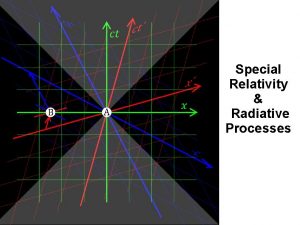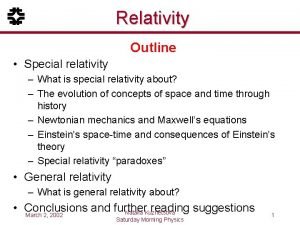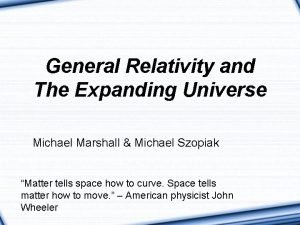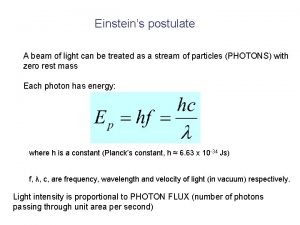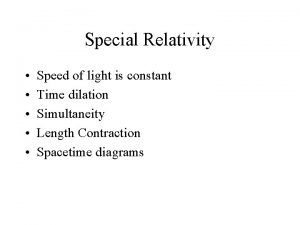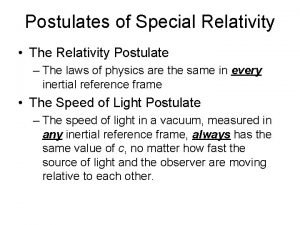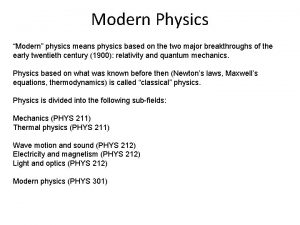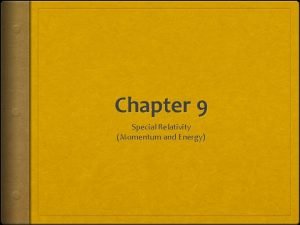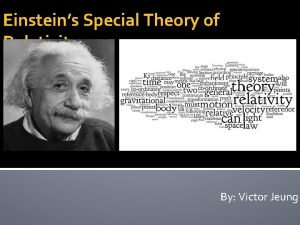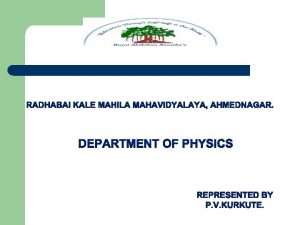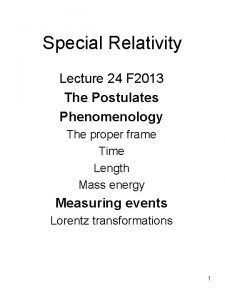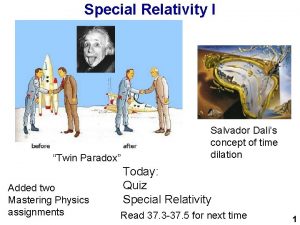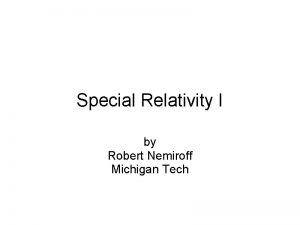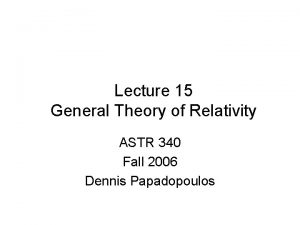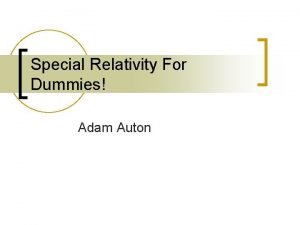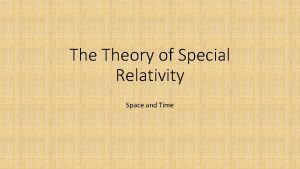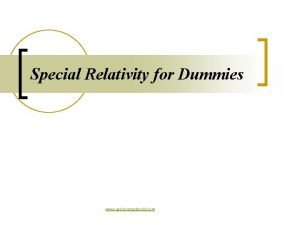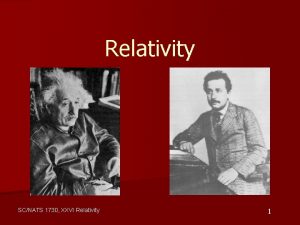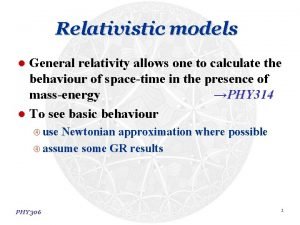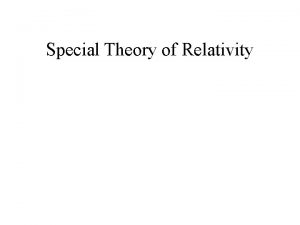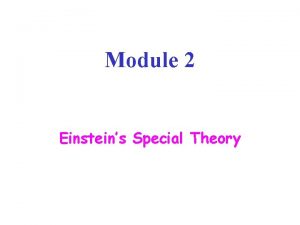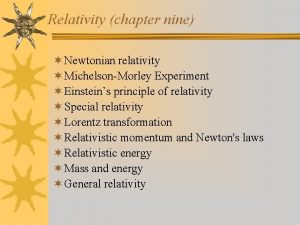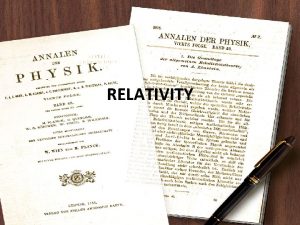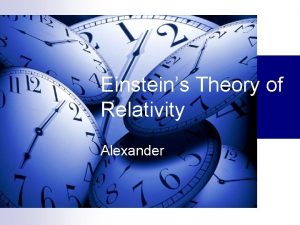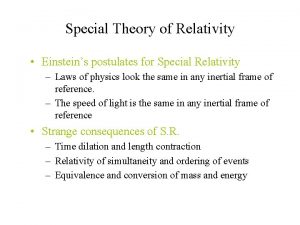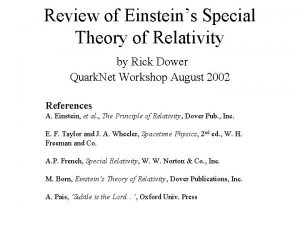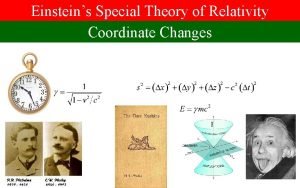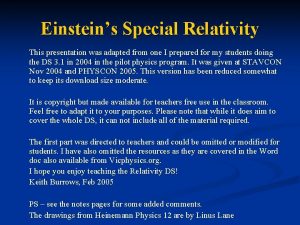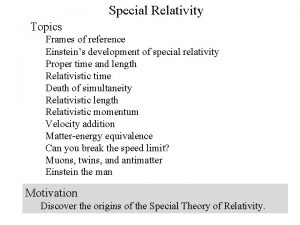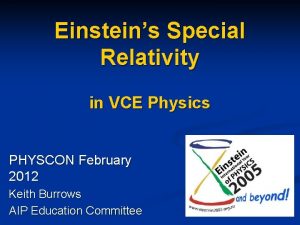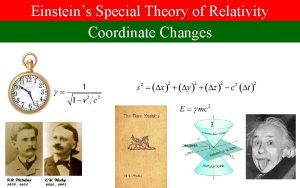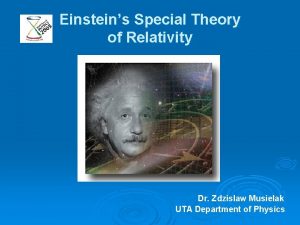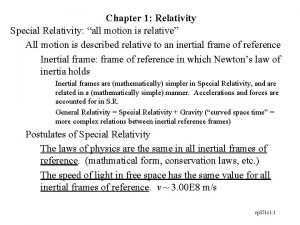Chapter 38 A Relativity Special Relativity Einsteins Special























- Slides: 23

Chapter 38 A - Relativity

Special Relativity Einstein’s Special Theory of Relativity, published in 1905, was based on two postulates: I. The laws of physics are the same for all frames of reference moving at a constant velocity with respect to each other. II. The free space velocity of light c is constant for all observers, independent of their state of motion. (c = 3 x 108 m/s)

Rest and Motion What do we mean when we say that an object is at rest. . . or in motion? Is anything at rest? We sometimes say that man, computer, phone, and desk are at rest. We forget that the Earth is also in motion. What we really mean is that all are moving with the same velocity. We can only detect motion in reference to something else.

No Preferred Frame of Reference What is the velocity of the bicyclist? 25 m/s West We cannot say without a frame of reference. East 10 m/s Earth Assume bike moves at 25 m/s, W relative to Earth and that platform moves 10 m/s, E relative to Earth. What is the velocity of the bike relative to platform? Assume that the platform is the reference, then look at relative motion of Earth and bike.

Reference for Motion (Cont. ) To find the velocity of the bike relative to platform, we must imagine that we are sitting on the platform at rest (0 m/s) relative to it. We would see the Earth moving westward at 10 m/s and the bike moving west at 35 m/s. Earth as Reference 25 m/s 0 m/s 35 m/s East 10 m/s West Earth Platform as Reference West 10 m/s East 0 m/s

Frame of Reference Consider the velocities for three different frames of reference. Earth as Reference 25 m/s 10 m/s West Earth Platform as Reference 35 m/s West 10 m/s East 0 Bicycle as Reference East 0 m/s West 25 m/s East 35 m/s

Projectile Motion AP Physics B

What is projectile? Projectile -Any object which projected by some means and continues to move due to its own inertia (mass).

Projectiles move in TWO dimensions Since a projectile n moves in 2 dimensions, it therefore has 2 components just like a resultant vector. Horizontal and Vertical

Horizontal “Velocity” Component n NEVER changes, covers equal displacements in equal time periods. This means the initial horizontal velocity equals the final horizontal velocity In other words, the horizontal velocity is CONSTANT. BUT WHY? Gravity DOES NOT work horizontally to increase or decrease the velocity.

Vertical “Velocity” Component n Changes (due to gravity), does NOT cover equal displacements in equal time periods. Both the MAGNITUDE and DIRECTION change. As the projectile moves up the MAGNITUDE DECREASES and its direction is UPWARD. As it moves down the MAGNITUDE INCREASES and the direction is DOWNWARD.

Combining the Components Together, these components produce what is called a trajectory or path. This path is parabolic in nature. Component Magnitude Direction Horizontal Constant Vertical Changes

Horizontally Launched Projectiles which have NO upward trajectory and NO initial VERTICAL velocity.

Horizontally Launched Projectiles To analyze a projectile in 2 dimensions we need 2 equations. One for the “x” direction and one for the “y” direction. And for this we use kinematic #2. Remember, the velocity is CONSTANT horizontally, so that means the acceleration is ZERO! Remember that since the projectile is launched horizontally, the INITIAL VERTICAL VELOCITY is equal to ZERO.

Horizontally Launched Projectiles Example: A plane traveling with a horizontal velocity of 100 m/s is 500 m above the ground. At some point the pilot decides to drop some supplies to designated target below. (a) How long is the drop in the air? (b) How far away from point where it was launched will it land? What do I know? What I want to know? vox=100 m/s t=? x=? y = 500 m voy= 0 m/s g = -9. 8 m/s/s 1010 m 10. 1 seconds

Vertically Launched Projectiles NO Vertical Velocity at the top of the trajectory. Vertical Velocity decreases on the way upward Vertical Velocity increases on the way down, Horizontal Velocity is constant Component Magnitude Direction Horizontal Vertical Constant Changes Constant Decreases up, 0 @ top, Increases down

Vertically Launched Projectiles Since the projectile was launched at a angle, the velocity MUST be broken into components!!! vo q vox voy

Vertically Launched Projectiles There are several things you must consider when doing these types of projectiles besides using components. If it begins and ends at ground level, the “y” displacement is ZERO: y = 0

Vertically Launched Projectiles You will still use kinematic #2, but YOU MUST use COMPONENTS in the equation. vo q vox voy

Example A place kicker kicks a football with a velocity of 20. 0 m/s and at an angle of 53 degrees. (a) How long is the ball in the air? (b) How far away does it land? (c) How high does it travel? /s 0 0. v 2 = o q = 53 m

Example A place kicker kicks a football with a velocity of 20. 0 m/s and at an angle of 53 degrees. (a) How long is the ball in the air? 3. 26 s What I know vox=12. 04 m/s voy=15. 97 m/s y=0 g = - 9. 8 m/s/s What I want to know t=? x=? ymax=?

Example A place kicker kicks a football with a velocity of 20. 0 m/s and at an angle of 53 degrees. (b) How far away does it land? What I know vox=12. 04 m/s voy=15. 97 m/s y=0 g = - 9. 8 m/s/s What I want to know t = 3. 26 s x=? ymax=? 39. 24 m

Example A place kicker kicks a football with a velocity of 20. 0 m/s and at an angle of 53 degrees. (c) How high does it travel? What I know vox=12. 04 m/s voy=15. 97 m/s y=0 g = - 9. 8 m/s/s CUT YOUR TIME IN HALF! 13. 01 m What I want to know t = 3. 26 s x = 39. 24 m ymax=?
 Special vs general relativity
Special vs general relativity Special relativity equations
Special relativity equations Special vs general relativity
Special vs general relativity De broglie hypothesis
De broglie hypothesis Relative geschwindigkeitsaddition
Relative geschwindigkeitsaddition Special relativity
Special relativity Relativity definition
Relativity definition The law of relativity
The law of relativity Modern physics meaning
Modern physics meaning Momentum special relativity
Momentum special relativity Special relativity higher physics
Special relativity higher physics Special relativity summary
Special relativity summary Albert einstein theory of special relativity
Albert einstein theory of special relativity Postulates of special theory of relativity
Postulates of special theory of relativity Postulates of special theory of relativity
Postulates of special theory of relativity Special relativity
Special relativity Special relativity
Special relativity Eddington
Eddington Relativity for dummies
Relativity for dummies Theory of relativity
Theory of relativity Linguistic relativity definition
Linguistic relativity definition Relativity for dummies
Relativity for dummies Einstein thought experiment elevator
Einstein thought experiment elevator Relativistic acceleration calculator
Relativistic acceleration calculator
